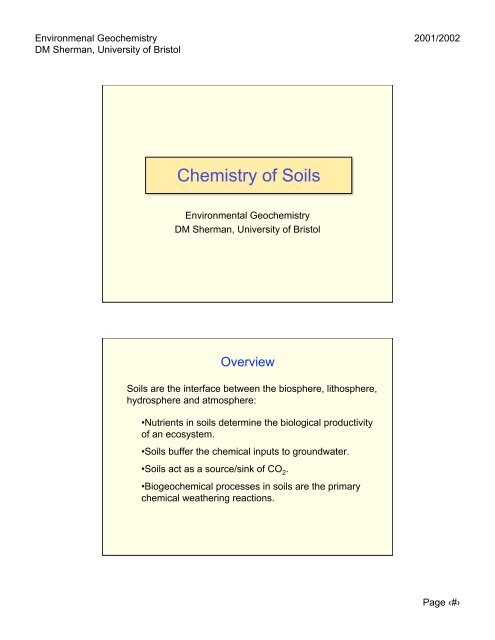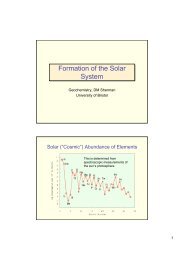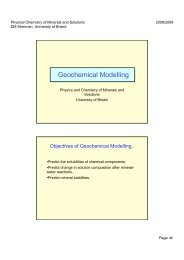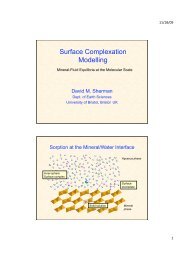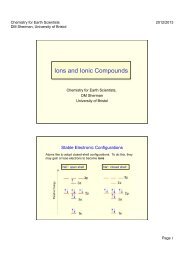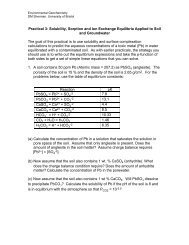Lecture Notes (PDF) - Aqueous and Environmental Geochemistry
Lecture Notes (PDF) - Aqueous and Environmental Geochemistry
Lecture Notes (PDF) - Aqueous and Environmental Geochemistry
Create successful ePaper yourself
Turn your PDF publications into a flip-book with our unique Google optimized e-Paper software.
Environmenal <strong>Geochemistry</strong>DM Sherman, University of Bristol2001/2002Chemistry of Soils<strong>Environmental</strong> <strong>Geochemistry</strong>DM Sherman, University of BristolOverviewSoils are the interface between the biosphere, lithosphere,hydrosphere <strong>and</strong> atmosphere:•Nutrients in soils determine the biological productivityof an ecosystem.•Soils buffer the chemical inputs to groundwater.•Soils act as a source/sink of CO 2 .•Biogeochemical processes in soils are the primarychemical weathering reactions.Page ‹#›
Environmenal <strong>Geochemistry</strong>DM Sherman, University of Bristol2001/2002FeOOHorganicmatterbacteriaComponents of Soilsquartz grainsSurfaceO : Organic matterA : Organics + mineralsE : Leached zone(mostly quartz)B : Colloids accumulated.(Clays <strong>and</strong> FeOOH)clayparticlesfungalhyphaeParent BedrockWater TableSoil (<strong>and</strong> Sediment) Texture <strong>and</strong>Mineralogy•S<strong>and</strong> Fraction is mostly quartz.•Clay fraction is phyllosilicate clays<strong>and</strong> Fe-Mn oxide hydroxides.S<strong>and</strong> = 0.05 - 2.0 mmSilt = 0.002 - 0.05 mmClay < 0.002 mmPage ‹#›
Environmenal <strong>Geochemistry</strong>DM Sherman, University of Bristol2001/2002Mineralogy of Soil Clay FractionWith increasingrainfall, “base cations”(Na + , Mg 2+ , Ca 2+ ) arereleased to leavebehind insoluble Fe-Al(hydr)oxides.Soil pH <strong>and</strong> Soil AcidificationPage ‹#›
Environmenal <strong>Geochemistry</strong>DM Sherman, University of Bristol2001/2002Significance of Soil pH/AciditySoil pH determines the solubility (<strong>and</strong> bioavailability) ofessential nutrients <strong>and</strong> toxic species (e.g., Al(OH) n3-n).Soil AcidityActive acidity: Acidity associated with the solution phase.Reserve Acidity: all titratable acidity associated with thesolid phase. Two components:Non-exchangeble acidity: bound H + <strong>and</strong> Al 3+ that isnot displaced by concentrated neutral salts.Associated with organics <strong>and</strong> bound Al-OH cations.Exchangeable Acidity: exchangeable Al 3+ in mineralsoils <strong>and</strong> exchangable H + in organic soils.Page ‹#›
Environmenal <strong>Geochemistry</strong>DM Sherman, University of Bristol2001/2002Acid-base Buffers in Soils•Carbonate buffers (pH > 7)H + + CO2-3 = HCO-3•Exchangeable “base cation” buffering (pH = 5.5 - 7)H + + Ca 0.5 (Mg 0.5 Al 3.5 )(Al 0.5 Si 7.5 )O 20 (OH) 4 =H(Mg 0.5 Al 3.5 )(Al 0.5 Si 7.5 )O 20 (OH) 4 + 0.5Ca2+•Aluminosilicate dissolution (pH < 5.5)2H + + 3KAlSi 3 O 8 + 3H 2 O =Al 2 Si 2 O 5 (OH) 4 + 7SiO 2 +Al(OH)-4 + 3K +Acid-base Buffers in SoilsPage ‹#›
Environmenal <strong>Geochemistry</strong>DM Sherman, University of Bristol2001/2002pH of Atmospheric Deposition in UKThe susceptibility of soils todamage by acid rain is stronglydependent upon the bedrocklithology:•Limestone <strong>and</strong> chalkdeposits are not susceptibleto acidification.•Rocks containing Al mineralssuch as feldspar, muscovite,are more susceptible.Consequences of Acidification(In Soils)•In soils, increased acidityreleases Al into the soilsolution (as Al 3+ , Al(OH) n3-n).The excess Al damagesroot hairs of plants.2H + + 3KAlSi 3 O 8 + 3H 2 O =Al 2 Si 2 O 5 (OH) 4 + 7SiO 2 +Al(OH) 4-+ 3K +Page ‹#›
Environmenal <strong>Geochemistry</strong>DM Sherman, University of Bristol2001/2002Solubility of Al vs. pHThe aqueous aluminum concentration that may resultfrom acidification is a function of the major mineralogy ofthe host rock.<strong>Aqueous</strong> Speciation of AlPositive cations (Al 3+ , Al(OH) 2+ <strong>and</strong> Al(OH) 2+ ) mayact as exchangeable cations in clay interlayers. Alhydroxyions may also sorb to mineral surfaces..Page ‹#›
Environmenal <strong>Geochemistry</strong>DM Sherman, University of Bristol2001/2002Consequences of Acidification (cont.)•Acid input also releases cations such as K, Ca, Mg fromsmectite clays <strong>and</strong> decreases soil fertility.H + + K(Mg 0.5 Al 3.5 )(Al 0.5 Si 7.5 )O 20 (OH) 4 =H(Mg 0.5 Al 3.5 )(Al 0.5 Si 7.5 )O 20 (OH) 4 + K+•Release of Al also leads to the formation of AlPO 4 (atlow pH) <strong>and</strong> limits phosphate bioavailability. At higherpH, Al(OH) 3 <strong>and</strong> related phases sorb HPO 4-2by surfacecomplexation.Nutrients in SoilsPage ‹#›
Environmenal <strong>Geochemistry</strong>DM Sherman, University of Bristol2001/2002H1Li3Na11K19Rb37Cs55Fr87Be4Mg12NutrientsCa Sc Ti V Cr Mn Fe Co Ni Cu Zn20 21 22 23 24 25 26 27 28 29 30Sr38Ba56Ra88P is needed for ATP synthesis.N is needed for amino acid synthesis.Metal centers are needed for 1/3 of all proteins.Y39La57Ac89Zr40Hf73Nb Mo Tc41 42 43Ta73B5C6W Re Os Ir Pt Au Hg Tl Pb74 75 76 77 78 79 80 81 82U92Ru44Rh45Pd46O8F9Al Si P S Cl13 14 15 16 17Ce Pr Nd Pm Sm Eu Gd Tb Dy Ho Er Tm Yb Lu58 59 60 61 62 63 64 65 66 67 68 69 70 71Th90Pa91Ag47Cd48Ga31In49Ge32Sn50N7As33Sb51Bi83Se34Te52Po84Br35I53At85He2Ne10Ar18Kr36Xe54Rn86Solubility of ApatiteApatite is the main inorganic form of P <strong>and</strong> is theprimary mineral phase of bone.-101Ca 5(PO 4) 3OH +(n+1)H += 5Ca +2 + 3H nPO 4n-3 +H2 OpP total234562 3 4 5 6 7 8 9 10pHPage ‹#›
Environmenal <strong>Geochemistry</strong>DM Sherman, University of Bristol2001/2002Soil Nitrogen CycleSoil Pollution by Heavy MetalsPage ‹#›
Environmenal <strong>Geochemistry</strong>DM Sherman, University of Bristol2001/2002Soil Pollution by Heavy MetalsMost heavy metals of concern are chalcophiles(tend to bond with sulfur..).Heavy Metals of Particular ConcernMetalPbSoilBackground(mg/kg)10-84SoilLimit(mg/kg)500DWLimit(mg/kg)0.05SourcesPlumbing, petrol, paintAs2.2-25100.05Wood preservativesHg0.02-0.410.001Pesticides, miningZn17-1243005Electroplating,sludgeCd0.06-1.130.005P-fertilizers, sludgePage ‹#›
Environmenal <strong>Geochemistry</strong>DM Sherman, University of Bristol2001/2002Fundamental Chemical ProcessesControlling the Fate of Heavy Metals inSoilBiosphereDissolutionInsolublePrecipitates(e.g., PbCO 3 )<strong>Aqueous</strong> SolutionsorptiondesorptionFe (hydr)oxidesIon ExchangeLayer Silicate ClaysLead (Pb) in European SoilPage ‹#›
Environmenal <strong>Geochemistry</strong>DM Sherman, University of Bristol2001/2002Speciation of PbControls on [Pb] by Anglesite, PbSO 4Anglesite is too soluble to keep Pbconcentrations below recommendedlevels.Model soil solutionwith P CO2= 10 -3.5 .Formation of PbCO 3<strong>and</strong>Pb(CO 3) 22-complexes.Solubility of PbSO 4Solubility in presence ofGypsum, CaSO 4.2H 2OPage ‹#›
Environmenal <strong>Geochemistry</strong>DM Sherman, University of Bristol2001/2002Controls on [Pb] by Cerussite, PbCO 3Cerrusite can keep Pb concentrationsbelow recommended levels but onlyover a limited pH range.Solubility withP CO2= 10 -3.5 .Solubilitywith no CO 2.UK Drinking waterlimit.Sorption Edges to FeOOH(Approximate..)Page ‹#›
Environmenal <strong>Geochemistry</strong>DM Sherman, University of Bristol2001/2002Complexation of Metals by Humic/FulvicAcidsRemediation of Soil Polluted by HeavyMetals: Electrokinetic extractionPage ‹#›
Environmenal <strong>Geochemistry</strong>DM Sherman, University of Bristol2001/2002Soil Pollution by OrganicsPAH (Polycyclic Aromatic Hydrocarbons)in CreosoteOHOHphenolCH 3cresolnapthaleneBenzo-[a]-pyreneanthraceneCreosote is a common wood preservative butis now banned because it contains PAHs(carcinogenic). These are slow to degrade insoil.Page ‹#›


